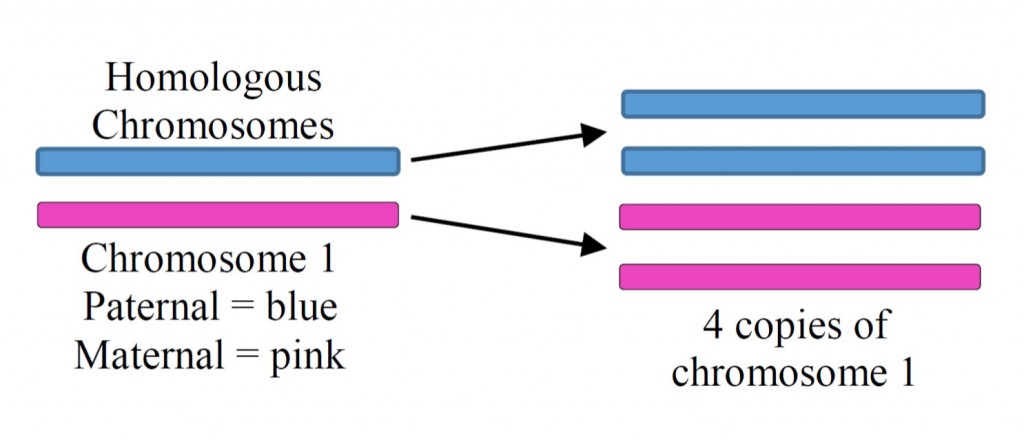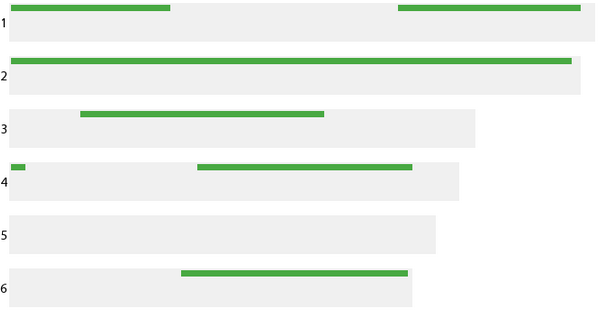Many genetic genealogists, myself included, often talk about DNA segments getting “broken up” or “broken down” as they are passed from one generation to the next. But this language can be misleading, since DNA isn’t really “broken up” into pieces when it passed down; instead, a few pieces are traded between nonsister chromosomes in a process called RECOMBINATION.
Genetic recombination is a process of crossover between chromosomes during MEIOSIS (meiosis = a very specialized cell division that creates eggs and sperm for reproduction). Very early in meiosis, the cells duplicate the chromosomes. Normally, every cell has 23 pairs of chromosomes, for a total of 46 chromosomes. However, in the first step of meiosis, the chromosomes are duplicated to result in a total of 92 chromosomes. There are 4 copies of chromosome 1 (2 copies of the chromosome you got from your mother, and 2 copies of the chromosome you got from your father). There are 4 copies of chromosome 2, and so on.
Recombination can now occur between any of the 4 copies of chromosome 1. If recombination occurs between the two paternal or two maternal copies of chromosome 1 (between SISTER chromosomes), then there is no detectable change since they are identical copies. If recombination occurs between a maternal and a paternal chromosome (between NONSISTER chromosomes), then a detectable crossover occurs:
A descendant will then randomly get ONE of the above four chromosomes; sometimes there will be one or more recombination events, and sometimes there won’t.
Recombination varies by chromosome. For example, according to my understanding of Table S1 of this paper (“Genetic Analysis of Variation in Human Meiotic Recombination”), there is an average of 1.23 (female) or 0.93 (male) recombination events on chromosome 20. Some people will have more recombination events, while others will have fewer. Females tend to have more recombination events than males.
Visualizing Recombination
Below is a graph of DNA shared between a paternal grandmother and her granddaughter, which shows the recombination that occurred at a single generation (i.e., when the father generated a sperm):
On chromosome 1, for example, there were two recombination events (denoted by the arrows) (there may also have been a third recombination at the end of chromosome 1):
On chromosome 6, there was a single recombination event:
On chromosomes 2 and 5, there was no recombination between NONSISTER chromosomes, and thus the granddaughter inherited her grandmother’s entire chromosome 2 (and, by process of elimination, her grandfather’s entire chromosome 5):
(Note that there may have been recombination between SISTER copies of chromosome 2, but that would be undetectable).
Importantly, the DNA from the grandmother that wasn’t passed on due to recombination is now lost to the grandchild and future generations (unless it comes back in from other lines). For example, none of the granddaughter’s descendants will inherit DNA from her grandmother’s chromosome 5.
“Broken Down” DNA
As I noted before, we often talk about DNA being “broken down” or “broken up” into smaller pieces that are inherited. This can be a bit misleading if it is interpreted by a reader to mean ‘a single segment is broken into multiple small segments by recombination.’ While technically every recombination event breaks a segment into a smaller segment, it does not weave back and forth multiple times between nonsister chromosomes. Indeed, with an average of just 2-3 recombination events for chromosome 1, we don’t see recombination that looks like this:
There would have had to be 12 recombination events to create the graph above, most of which were just a few cM apart. While not necessarily biologically impossible (with genetics I often feel like almost nothing is impossible!), it is statistically improbable based on the studies that have been completed to date. In order to conclude that the recombination like the above has occurred, we would have to scientifically eliminate every other possibility with some confidence, particularly ones that are more easily explained (IBC or ancient IBS segments, or gaps in sequencing, or matching errors, for example). And given the very high rate of false positives resulting from either IBC or ancient IBS, this is extremely hard to prove with any confidence.
Getting Smaller – The Next Generation
At the next generation, the granddaughter’s paternal chromosome 1 can be further “broken down” into smaller pieces when she passes it on to her children. As just one example, see the below:
 Here’s another example where recombination created a small piece of DNA on this chromosome:
Here’s another example where recombination created a small piece of DNA on this chromosome:
And this is how DNA segments can get smaller from one generation to the next.
But importantly, we CANNOT see the following:
The granddaughter’s descendants cannot reclaim DNA from the grandmother that was not originally passed down to the granddaughter (unless it comes back in at a future point from another line). So the great-grandchild COULD have this match with the great-grandmother, but they would have had to obtain the central segment from their father.
Other Recombination Graphs
There aren’t many graphs available out there that clearly show recombination events, but here are a few links:
- “Known Relative Studies with 23andMe: Great Grandchild DNA Inheritance”
- “Using the Chromosome Mapper to make a four generation inheritance picture”
- “Looking at recombination”
Feel free to leave more links in the comments.










Thank you Blaine for taking the time to write this and for explaining the concepts so clearly. The graphics really help to get the point across. In case it’s of interest there is a collection of articles on the subject of recombination in the ISOGG Wiki:
http://www.isogg.org/wiki/Recombination
I’ve added your blog post to the list!
I have a two-generation example here showing how two out of three segments didn’t get passed on to the next generation and the third segment was passed on intact:
http://cruwys.blogspot.co.uk/2014/06/my-first-autosomal-dna-success-story.html
Thank you Debbie! I should have guessed the ISOGG Wiki has a recombination page, it has everything else. Thank you so much for all you do there. I’ll go check out your blog post now, thanks for the link.
I’ve always liked the graphics on this page, which seem to depict some of the things you were talking about: http://www.dnainheritance.kahikatea.net/autosomal.html
Don – that’s a classic, and I didn’t think of it! Thank you very much for adding it. The visuals there demonstrate that other than the ends of chromosomes, there aren’t multiple successive small segments that result from recombination.
Thanks so much for this post, Blaine. It’s going to help a lot of people understand the process, and I know I will be sharing it.
I have two questions and hopefully someone can help me out with answers.
1. If during meiosis there are 4 chromosomes some of which may have gone through recombination per your example, and we inherited two, one from each parent why do you say, “A descendant will then randomly get ONE of the above four chromosomes;” wouldn’t we get a random selection of Two?
2. If one of our chromosomes has been recombined, does that mean it is possible for a father’s descendant or relative to match us on what would otherwise be our maternal side of a chromosome and vice versa?
Because of another diagram I just found I think I have answered my own questions. Thank Plos http://journals.plos.org/plosgenetics/article?id=10.1371/journal.pgen.1000648 – figure 1.
Thank you for the clear explanation of recombination. I have a question: why do some chromosomal segments seem to be more “resilient” than others, and retain their integrity through many generations? I have noticed on 23andMe that I have one persistent segment on chromosome six in common with several relatives, yet our common ancestor appears to be up to 10 generation ago! Why has this segment stayed intact where other segments “break up”?
A great article on showing how DNA segments get smaller though chromosomes play an important role in a combination. Here you can find all the popular at-home DNA kits which are popular in today’s market and are really productive in their own way. https://www.dnatestreview.org/